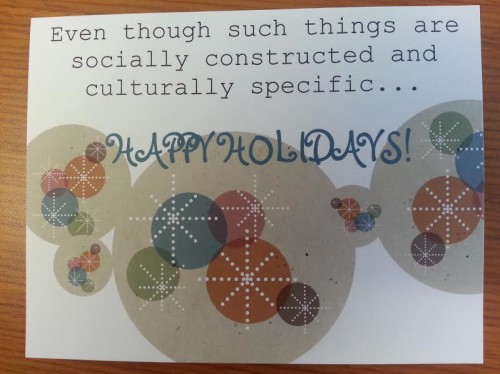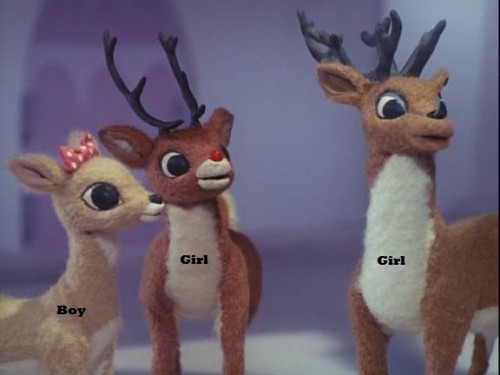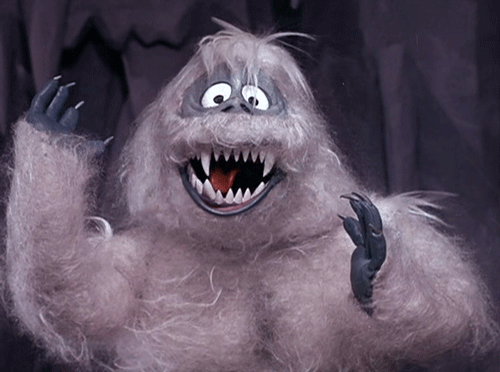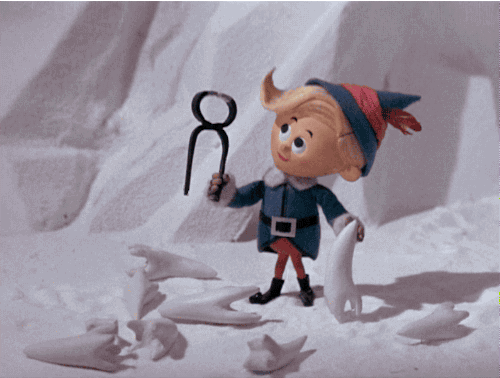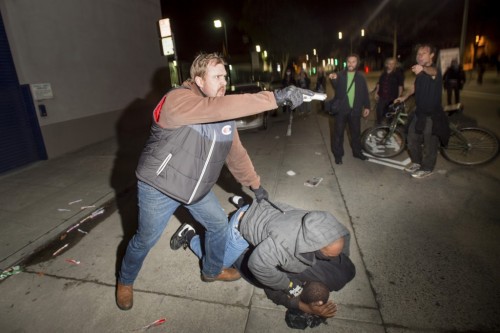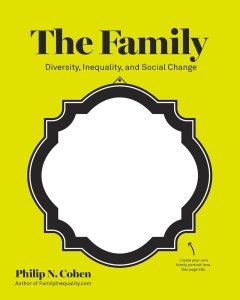A merry day of celebration to those of you who care, from The Society Pages and card-maker extraordinaire, Letta Page!
Lisa Wade, PhD is an Associate Professor at Tulane University. She is the author of American Hookup, a book about college sexual culture; a textbook about gender; and a forthcoming introductory text: Terrible Magnificent Sociology. You can follow her on Twitter and Instagram.Thansk to Meia G. for sending in these “tool set” ornaments for sale at Home Depot. Notice that they don’t just group these tools into ones associated with women (gardening) and men (building), they actually label them as women’s and men’s on the price sticker. This is a great example of how gender isn’t just something we encounter in objects because we know enough to read gender into them, it’s actually prescribed to us.
Christmas gift advertising tends to be highly gendered in part because buying gifts can be difficult and time-consuming. Gender helps us narrow down options or find something that seems suitable for someone we don’t know very well. Marketers exploit this imperative and its uncertainty for all its worth.
And perhaps all this was just an excuse to re-post Sarah Haskins on holiday jewelry advertising. You’re welcome.
I added the tools sets to our constantly expanding collection of pointlessly gendered products. It’s our most popular Pinterest board and we can see why! Recent additions include gendered pickles; “Junior Park Ranger” and “Park Princess” vests for sale at a Yellowstone gift shop; scissors, q-tips, and dryer sheets for men only; and globes and glue just for girls.
Lisa Wade, PhD is an Associate Professor at Tulane University. She is the author of American Hookup, a book about college sexual culture; a textbook about gender; and a forthcoming introductory text: Terrible Magnificent Sociology. You can follow her on Twitter and Instagram.Sure to be a classic!
The tale begins with a baby calf named Rudolph born to what is assumed to be a typical reindeer family. Immediately we recognize that this is no typical Hollywood tale. As we all know, male reindeer lose their antlers in late fall, but female retain throughout the Christmas season. By making Rudolph, Donner (the head of the family), and all of Santa’s reindeer female, the film makes a strong departure from the androcentric status quo.
The new baby girl fills the house with joy until the parents discovered the calf to be quite queer—Rudolph had a red nose that glowed. Initially ashamed, Donner drew on a very functional and literal cover-up of mud and clay to hide the nose. It is believed this was for the good of the calf as this story was set in a pretty cruel place—a place where even Santa was unkind and unaccepting of differences.
Spring training comes along with masculinity classes for Rudolph. This was a highlight of the story for me. It was nice to see time was taken to demonstrate that gender is socially constructed and masculinity is learned. Girls can do anything that boys can do and our young protagonist was exceptional, even best in the class.
However, the mud and clay would be an impermanent fix. Rudolph’s glowing nose was revealed during play and the names and bullying began. In fact the bullying was even legitimated by the coach. With such an unaccepting family and community, Rudolph runs away.
Meanwhile, in (one of) Santa’s workshops, an elf named Hermey was having a Jerry McGuire day. Hermey, perhaps the most relatable character to mainstream American society, was questioning the system. Hermey wanted to do what made him happy. He wanted to be a dentist. Working in an assembly line factory with long hours and no dental was not living the dream. Hermey decides he is a Dentist and also sets out alone.
Unsurprisingly, Rudolph and Hermey run into each other on the path out of town, also called loneliness. After a day in the polar wilderness they meet another queer named Yukon Cornelius who is always in search of gold or silver.
The three misfits then encounter the abominable snow monster. “Mean and nasty,” he “hates everything about Christmas.” Clearly, his teeth and wide reaching claws are designed to compel compliance with the social order. White, male, and against magic for the masses, this character is clearly intended to represent the kyriarchy, the system meant to uphold the intersecting oppressions of class, race, and gender. The movie’s central challenge is set: smash the kyriarchy.
The group initially retreats, only to find themselves on The Island of Misfit Toys where they are greeted by a flamboyant Charlie-in-the-box. It is here Hermey and Rudolph begin to dream of having an accepting place and we see the strong desire for a community. Surely, if dolls with low esteem, pink fire trucks, and trains with square wheels can be free of oppression, they can too.
Emboldened, the trio now returns to kill the kyriarchy. Using the never fail logic that bacon trumps all meats, Hermey makes like a pig to get the abominable snow monster’s attention. Once the snow monster steps out of the cave, Yukon knocks him out by dropping a boulder on his head; Hermey pulls out all his teeth in a symbolic and literal de-fanging.
Yukon pushes the monster off a cliff, but he falls, too. This is the most symbolic part of the tale, as the group has bonded together to kill the kyriarchy but not without some loss. The message is clear: if we build alliances, we can take down the power elite, but there will be sacrifices.
I will not ruin the end of the tale for you, only to say that Rudolph does in fact save Christmas, but it is by demonstrating value to the man—Santa. Once Santa sees Rudolph and his misfit friends as an asset he de-identifies at least slightly with the kyriarchy. For now, Christmas town was a cheerful place. A small battle had been worn.
Overall, Rudolph the Red Nose Reindeer gets two thumbs up!
It is sure to become a classic tale of systems of oppression and privilege, stigma, and the struggle for self-acceptance. In Rudolph, difference can be good. It was quite progressive with its message advocating inclusivity, alliance, and dissent against systems of power. I love the commentary on the lack of queer community organizing and the role of misfits in fighting capitalism and the power elite. It took on some hot button issues in nuanced ways, especially the policing various classes of citizens and the importance of open carry laws.
It also took some big risks related to casting. It was gender progressive and, outside of the binary, we have at least two characters that blur sex categories. Clarice, for example, presents as feminine and female pronouns are employed with her, yet she has no antlers in late winter. While Hermey dresses like the male elves, but he has swooping blonde hair and a small nose like the female elves.
For years to come, Rudolph will no doubt be a wonderful conversation starter for both awkward and fun winter gatherings alike.
D’Lane R. Compton, PhD is a lover of all things antler, feather, and fur. An associate professor of sociology at the University of New Orleans with a background in social psychology, methodology, and a little bit of demography, they are usually thinking about food, country roads, stigma, queer nooks and places, sneakers and hipster subcultures. You can follow them on twitter.
Yes, but it was a weird thing you see.
The Nazis were waging war and exterminating Jews. Meanwhile, Christmas was about celebrating peace and the birth of Jesus, a Jew.
Said the Nazi propagandist Friedrich Rehm in 1937:
We cannot accept that a German Christmas tree has anything to do with a crib in a manger in Bethlehem. It is inconceivable for us that Christmas and all its deep soulful content is the product of an oriental religion.
But Germans were largely Christian, so getting rid of Christmas was going to be tricky. So Hitler turned it into a celebration of the Third Reich. According to John Brownlee, they re-wrote Christmas carols to extol the virtues of National Socialism. Mentions of Jesus were replaced with “Savior Führer.” Since they well understood that Santa wasn’t white, they re-cast the character; he was played by the pagan god Odin. And they changed the ornaments and placed swastikas atop Christmas trees.
Here are links to a Hitler ornament and Nazi tree topper, swastika cookie cutter, and swastika ornaments:
The last Nazi Christmas was in 1944. Post-war Germany quickly “did with Hitler’s Christmas what they did with every other idea the Nazis had come up with: denounced it…”
Photo by Monado flickr creative commons.
Lisa Wade, PhD is an Associate Professor at Tulane University. She is the author of American Hookup, a book about college sexual culture; a textbook about gender; and a forthcoming introductory text: Terrible Magnificent Sociology. You can follow her on Twitter and Instagram.Iconic images — such as a single student standing stoic before Red Army tanks in Tiananmen Square, a protester leaning forward to put a flower into the barrel of a soldier’s gun, or two African-American athletes raising black-gloved fists on the Olympic victory podium — often seem to shape much of what we “know” about various historical events or social movements. In our social media, mass culture world, images and interpretations spread fast. But where do these images come from? How and by whom are they produced?
Last week, wire services photographer Noah Berger found himself behind the lens of a photograph that has the potential to become such an image. In it, a white, plain-clothes police officer in Oakland, CA, aims his gun at protesters and reporters, while his black partner holds down a black protester. At a historical moment when protests are sweeping the country, bringing issues of police violence and the unequal treatment of minorities into public consciousness with slogans like “Black Lives Matter,” it is perhaps not surprising that the photo seems to have gone viral.
Sociologist Joshua Page reached out to Berger to discuss the photographer’s experience in creating this powerful image. In an interview, the two talked about the social logistics of photographing protests, the life of a “stringer,” and the struggle to capture the essence—even the sociological significance—of events that have complex backstories and often conflicting meanings in single, silent photographs.
1. The Photo.
Page: Why was the police officer pointing his gun at people?
Berger: In basic, loose terms, what happened on the night that the plain-clothes officer pulled his gun on the protesters began with protests on the Berkeley campus, about 7:00pm. They disrupted a lecture by, I think, one of the founders of Paypal, but they marched peacefully for a couple of hours. It was about 150 people, and they marched all the way from the Berkeley campus to downtown Oakland—about three miles.
When it reached downtown Oakland, at 14th and Broadway, which is sort of “protest central,” it started getting a little bit edgier. You could just feel it in the crowd… Pretty soon after that, the first window got smashed. Then the cell phone store got looted. I watched that happen. I couldn’t take any pictures, but I did watch it.
So, the protesters kept marching, banging on windows. There was some minor vandalism, and, according to the California Highway Patrol [CHP], when the cell phone store was looted, that was when two officers who had been in a car behind the protest group got out and started walking with the group. This is all according to the CHP.
I noticed the officers in the crowd, and I actually thought they looked kind of scary. I made a mental note to stay away from them. They didn’t strike me as cops, they just looked kind of scary. But as far as I saw, they just walked along with the crowd. There have been some reports of them doing other things… but all I saw them doing was walking along with the group.
About 20 to 30 minutes after the first vandalism started, a group of roughly 60 people were walking, and someone just turned on these two guys and started yelling that they were cops. Kind of taunting them. More people joined in. At that point, the San Francisco Chronicle photographer tells me, somebody ran up behind the cops and pulled the hat off one of the guys, threw it on the ground. Apparently another person hit one of the officers on the back of the head. This is according to the Chronicle.
At that point, one of the officers in the crowd and a guy just started scuffling. It just turned into a brawl, and the crowd started advancing on these two officers. At that point, one of the officers pulled out a baton, which you can see in some of the pictures, and he also pulled out his firearm. He kind of aimed at the crowd and swung it around, saying something to the effect of, “Stay back! Back off.” He held them off for about 30 seconds until the regular, uniformed officers swooped in from the end of the block. They formed a protective semi-circle around these two guys and the protesters they were detaining, and pushed the other protesters backwards to secure the area.
Page: At what point did he point the gun at the Chronicle’s photographer?
Berger: I very much doubt that the cop knew the guy was press and was specifically pointing at him. He was holding the crowd back. It was more general, to everybody, “Stay back.” And in the picture, his hand isn’t on the trigger. So, I don’t think he was specifically targeting the press. It was just that we were close to him.
Page: Have you been surprised at how widely that image has been circulated and the ways people have interpreted it on Facebook and elsewhere?
Berger: Very much so. Michael Short, the Chronicle photographer and I, when we talked about it right after it happened, we thought the story was gonna be, “How crazy is this that a group of protesters knowingly attacked undercover officers?” That’s what we thought was the amazing part of the moment!
But after that picture came out, it conveyed a different perspective: “How crazy is it that this undercover cop would pull his weapon on protesters?” It’s a really good case of the picture not showing the whole story. It’s not a lie. It definitely is part of the story, but it’s not the whole occurrence.
It’s led to a cascade of interest that I’ve never really seen before, which was weird and mostly good. Not all good, but mostly good.
2. The job.
Page: So, what is your job title?
Berger: I’m a freelance photographer, a “stringer.”
Page: Do you see yourself as a photojournalist?
Berger: Yeah, I kind of wear two hats. It changes depending on the season, but I spend about 60% of my time on the news and about 40% in corporate or government work. But when I’m out during the protests, I certainly consider myself a photojournalist.
Page: Are there particular assignments you like to take?
Berger: Definitely the protests, the edgier protests are high on my list. That, and wildfires. My favorite assignments are protests and wildfires.
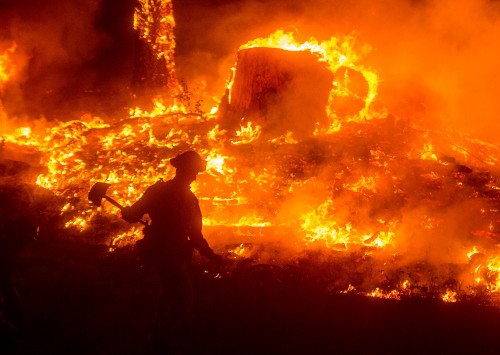 The King Wildfire, 2014. © Noah Berger
The King Wildfire, 2014. © Noah Berger
Page: What is it you like about them?
Berger: The wildfires are great, because you’re in these volatile, somewhat dangerous situations, but no one’s aiming for you, unlike in the protests. You’re out in the woods, trying to get your shot, and you’re not dealing with the public relations side or negotiating society. You’re just on your own.
The protests, it’s just interesting to see when there are clashes and when the emotions and violence flare up. And on another side, it’s just interesting to see that side of life. It’s something a lot of people don’t witness.
Page: Are there particular types of images you’re looking for when shooting a protest?
Berger: Sure. Working for the wire services like the AP or Reuters, I try to keep in mind one image that sums up an event. I’m not just looking for one image from the night, but I like my images to say something. When you’re working for a wire service, it’s more important to consider an audience outside the local area and know that you’re looking for images that sum up the event.
Page: Those tend to be more dramatic images.
Berger: “Dramatic,” like for the police protests, obviously would be something that might have a policeman and a protester in it, and some interaction. But it doesn’t need to be. Reuters, another photographer, got a shot of this guy with fire around him and a sign that said “Black Lives Matter.” There’s no other context, but it just had a great feeling. So it doesn’t need to be both sides, but I think the photo needs to speak to the whole issue.
Page: How do you know when the picture represents what’s going on?
Berger: You just kind of know when it happens, I guess…
Page: Another shot you had the other day, of the freeway stopped in both directions, was just amazing.
Berger: That’s actually a little different than I normally shoot; it doesn’t tell the story as quickly as the images I would normally look for. It took me longer to warm to that photo, because it was harder to “read.” You need more context [to know that these are protesters stopping traffic on a freeway].
Page: What’s your process for shooting a protest? How do you know where to go?
Berger: Well, there are a couple different ways. To find out where the protest is gonna be, there’s a website that lists the bigger ones. Twitter has become huge. A lot of these protests are just organized a couple hours before by someone saying, “Hey, let’s meet at 7:00 at the corner of _______ and _______,” and that just creates the protest. So, Twitter’s good.
I also use a police scanner, and I’ll have that on, depending on what the protest is. Like, if there are multiple protest groups roaming the streets, that’s really useful…. The other way is following, if there are multiple groups, following where the police helicopters are. You can look up and kind of figure that out. But the scanner’s a really useful tool.
3. Interactions: Protesters, Police, and the Press Corps.
Page: Do you ever get pushback from protesters, get hassled?
Berger: All the time. When I’m out there, my primary concerns are staying safe from protesters, staying safe from the police projectiles or clubs, and just keeping my gear safe.
Page: I’m sure there must be times when the idea of a protest is to get the images out there and spread the word. Are there times when your relationship with the protesters is more collaborative than antagonistic?
Berger: It’s not necessarily true, actually, that they want the word out. There’s definitely a large group that does want the world to know what’s going on here… but a lot of people seem to want to be out there pushing the boundaries of police and society and don’t want it documented.
Page: Is there a sense in some protests that the press is part of the “system” people are protesting to begin with?
4. Framing and Representation.
Page: Do you think about potential public or political reactions to the images when you’re shooting them?
Berger: Yeah. And I have a strong belief that we’re showing the world what’s happening in any given situation. I mean, that moment with the handgun coming up, you’re not gonna see that otherwise. There were, plus or minus, three mainstream journalists there, and we’re really the eyes of “truth” in the bigger, somewhat objective reality that’s being conveyed to the world.
Page: Do you think about how certain images would support particular narratives?
Berger: Sure. I think there’s an inherent bias toward, in protests, the sparky, edgy action shot. It’s not because we want to show protesters [as violent], but it makes for more dramatic pictures… I don’t ever go into it going, “I’m gonna take a shot that makes this side look like this,” but sometimes when you’re editing, you can see that. “Oh, this shot really conveys this.”
Page: You’re aware that certain images support certain perspectives, and recognize that sometimes you’re emphasizing the edgier side of a protest when a lot of it is peaceful. Like you were saying, all the way from Berkeley to downtown Oakland…
Berger: I am very conscious of that: one image can convey something that isn’t the whole truth. I try, when I write my caption, to reflect that. When I covered Occupy, if there was a protest where 1,500 people shut down a port and then 100 people broke windows, in my caption I’d say, “After a largely peaceful protest of 1,500 people…” There is definitely a responsibility beyond the image.
Page: So, what is your view of the current wave of protests? Do you think they’re effective? Justified?
Berger: I definitely don’t feel comfortable speaking to whether they’re justified… I don’t think any mainstream journalist trying to report from an objective position should put out their opinion on an issue they’re covering…. Our job is to stay, to try to stay as objective and neutral and balanced as we can. Telling our opinion would fall outside those boundaries, so it’s not something I’m comfortable talking about. …You could definitely be looking at a group on any side of an issue and think… “That’s kind of wacky,” but it’s still your job to stay objective and present all sides to an issue.
5. Letting Go.
Page: It must be really interesting to shoot the images, put them out there, and see how people respond to them and use them. I’ve seen this undercover cop photo turned into a meme. Do you pay attention to how they get written up and used?
Berger: On this story, I have been, definitely, but not always. I mean, there are all kinds of ironic things. This one was used as a protest poster for this coming weekend’s protest. I’m sure some of the people, maybe even the people designing the poster, are gonna be out there blocking my camera! Usually, the photos just sort of go off into the media world, and they’re gone for me.
Joshua Page, PhD, is a professor of sociology at the University of Minnesota, where he specializes in crime and deviance. He is the author of The Toughest Beat: Politics, Punishment, and the Prison Officers Union in California. This post originally appeared at The Society Pages.
- Militarizing Santa: Then and Now (pictured)
- A Short History of Santa Claus
- Politics and the Rockefeller Center Christmas Tree
- The Pagan Roots of Christianity
Christmas Across Cultures
- Befana, the Christmas Witch
- Christmas Cultures
- Santa’s Evil Side Kick
- Black Pete (NSFW; trigger warning for images of blackface)
- Protestantizing Christmas Gift Giving: The ChristKind
- Snegurochka: Santa’s Granddaughter
- Global Christmas
- Culture and Coordinating Human Action
- Jewish Christmas — The Chinese Connection
The Economics of Christmas
- Disguising the Gift of Money
- International Comparison of Christmas Spending
- Christmas has an Economy
- The Christmas Tree Industry
- 1/3rd of People Say Commercialism is the Worst Part of Christmas
Racializing Christmas
- Racism and Xenophobia in “War on Christmas” Rhetoric
- White Privilege and the Snow White Santa
- New York Times Gift Guide for People of Color
- Black Pete (NSFW; trigger warning for images of blackface)
- Holiday in the Hood
- The Hazards of Historical Amnesia
Christmas and Gender
- Gender-Swapping Christmas
- Mariah Carey’s “All I Want for Christmas is You”: 1994 versus 2011
- 12 “Mums” Makes the Workload Light
- Christmas is Women’s Work
- Tis the Season for Reinforcing Gender Differences
- Holidays: A Time for Men to Buy Themselves Stuff
- Christmas at the White House: A Role for the First Lady
Gift Guides and the Social Construction of Gender
- The Heterosexual Gift Giving Imperative
- Gender, Technology, and Toys ‘R Us
- Gender in Toy Catalogs
- Body Messages in Christmas-Themed Ads
- Gift Giving with Gender Stereotypes
- More Gender Gift Giving and Advertising
- Another Gendered Gift Guide
- And more Gendered Gift Guides
- And more Gendered Gift Guides!
- Or, you could just buy her a clothesline
Sexifiying Christmas
Christmas Marketing
- Support the Troops. Shop Walmart?
- Fun with the 2009 Target Catalog
- Guns for Christmas
- A Shorty History of Santa Claus
- 1930s Ad Touting Razor Technology
- Gap Thinks Girls are Vapid
On Discourse:
First, a note on language
In American English books from 1910 to 1950, about 25% of the uses of “family” were preceded by “the.” Starting about 1950, however, “the family” started falling out of fashion, finally dropping below 16% of “family” uses in the mid-2000s. This trend coincides with the modern rise of family diversity.
In her classic 1993 essay, “Good Riddance to ‘The Family’,” Judith Stacey wrote,
no positivist definition of the family, however revisionist, is viable. … the family is not an institution, but an ideological, symbolic construct that has a history and a politics.
The essay was in Journal of Marriage and the Family, published by the National Council on Family Relations. In 2001, in a change that as far as I can tell was never announced, JMF changed its name to Journal of Marriage and the Family, which some leaders of NCFR believed would make it more inclusive. It was the realization of Stacey’s argument.
I decided on the title very early in the writing of my book: The Family: Diversity, Inequality, and Social Change. I agreed with Stacey that the family is not an institution. Instead, I think it’s an institutional arena: the social space where family interactions take place. I wanted to replace the narrowing, tradition-bound term, with an expansive, open-ended concept that was big enough to capture both the legal definition and the diversity of personal definitions. I think we can study and teach the family without worrying that we’re imposing a singular definition of what that means.
It takes the unique genius that great designers have to capture a concept like this in a simple, eye-catching image. Here is how the artists at Kiss Me I’m Polish did it:
What goes in the frame? What looks like a harmless ice-breaker project — draw your family! — is also a conceptual challenge. Is it a smiling, generic nuclear family? A family oligarchy? Or a fictional TV family providing cover for an abusive, larger-than-life father figure who lectures us about morality while concealing his own serial rape behind a bland picture frame?
Whose function?
Like any family sociologist, I have great respect for Andrew Cherlin. I have taught from his textbook, as well as The Marriage Go-Round, and I have learned a lot from his research, which I cite often. But there is one thing in Public and Private Families that always rubbed me the wrong way when I was teaching: the idea that families are defined by positive “functions.”
Here’s the text box he uses in Chapter 1 (of an older edition, but I don’t think it’s changed), to explain his concept:
I have grown more sympathetic to the need for simplifying tools in a textbook, but I still find this too one-sided. Cherlin’s public family has the “main functions” of child-rearing and care work; the private family has “main functions” of providing love, intimacy, and emotional support. Where is the abuse and exploitation function?
That’s why one of the goals that motivated me to finish the book was to see the following passage in print before lots of students. It’s now in Chapter 12: Family Violence and Abuse:
We should not think that there is a correct way that families are “supposed” to work. Yes, families are part of the system of care that enhances the lived experience and survival of most people. But we should not leap from that observation to the idea that when family members abuse each other, it means that their families are not working. … To this way of thinking, the “normal” functions of the family are positive, and harmful acts or outcomes are deviations from that normal mode.
The family is an institutional arena, and the relationships between people within that arena include all kinds of interactions, good and bad. … And while one family member may view the family as not working—a child suffering abuse at the hands of a trusted caretaker, for example—from the point of view of the abuser, the family may in fact be working quite well, regarding the family as a safe place to carry out abuse without getting caught or punished. Similarly, some kinds of abuse—such as the harsh physical punishment of children or the sexual abuse of wives—may be expected outcomes of a family system in which adults have much more power than children and men (usually) have more power than women. In such cases, what looks like abuse to the victims (or the law) may seem to the abuser like a person just doing his or her job of running the family.
Huxtable family secrets
Which brings us to Bill Cosby. After I realized how easy it was to drop photos into my digital copy of the book cover, I made a series of them to share on social media — and planning to use them in an introductory lecture — to promote this framing device for the book. On September 20th of this year I made this figure and posted it in a tweet commemorating the 30th anniversary of The Cosby Show:
Ah, September. When I was just another naïve member of the clueless-American community, using a popular TV family to promote my book, blissfully unaware of the fast-approaching marketing train wreck beautifully illustrated by this graph of internet search traffic for the term “Cosby rape”:
I was never into The Cosby Show, which ran from my senior year in high school through college graduation (not my prime sitcom years). I love lots of families, but I don’t love “the family” any more than I love “society.” Like all families, the Huxtables would have had secrets if they were real. But now we know that even in their fictional existence they did have a real secret. Like some real families, the Huxtables were a device for the family head’s abuse of power and sexuality.
So I don’t regret putting them in the picture frame. Not everything in there is good. And when it’s bad, it’s still the family.
Philip N. Cohen is a professor of sociology at the University of Maryland, College Park. He is the author of The Family: Diversity, Inequality, and Social Change and writes the blog Family Inequality. You can follow him on Twitter or Facebook.
My sister-in-law Charlotte was recently loudly admonished by a flight attendant on an international flight for allowing her “breast to fall out” after she fell asleep while nursing her baby. A strong advocate for breastfeeding, Charlotte has shared with me her own discomfort with public breastfeeding because it is considered gross, matronly, and “unsexy.”
I heard this over and over again from women I have interviewed for my research: Women who breastfed often feel they have to cover and hide while breastfeeding at family functions. As one mom noted, “Family members might be uncomfortable so I leave room to nurse—but miss out on socializing.” This brings on feelings of isolation and alienation. Because of the “dirty looks” and clear discomfort by others, women reported not wanting to breastfeed in any situation that could be considered “public.”
Meanwhile, I flip through the June 2012 issue of Vanity Fair and see this ad:
We capitalize on the sexualization of the breast to raise awareness about breast cancer. Yet, we cringe at the idea of a woman nursing her child on an overnight flight.
What’s happening here? These campaigns send contradictory messages to women about their breasts and the way women should use them, but they have something in common as well: both breastfeeding advocacy and breast cancer awareness-raising campaigns tend to reduce women to body parts that reflect the social construction of gender and sexuality.
Breast cancer awareness campaigns explicitly adopt a sexual stance, focusing on men’s desire for breasts and women’s desire to have breasts to make them attractive to men. Breast milk advocates focus on the breast as essential for good motherhood. Breastfeeding mothers sit at the crossroads: Their breasts are both sexualized and essential for their babies, so they can either breastfeed and invoke disgust, or feed their child formula and attract the stigma of being a bad mother.
Both breastfeeding advocacy programs and breast cancer awareness-raising campaigns demonstrate how socially constructed notions of ownership and power converge with the sexualization and objectification of women’s breasts. And, indeed, whether breast feeding or suffering breast cancer, women report feeling helpless and not in control of their bodies. As Jazmine Walker has written, efforts to “help” women actually “[pit] women against their own bodies.”
Instead, we need to shift away from a breast-centered approach to a women-centered approach for both types of campaigns. We need to, as Jazmine Walker advocates, “teach women and girls how to navigate and control their experiences with health care professionals,” instead of pushing pink garb and products and sexualizing attempts to raise awareness like “save the ta-tas.” Likewise, we need to support women’s efforts to breastfeed, if they choose to, instead of labeling “bad moms” if they do not or cannot. Equipped with information and bolstered by real sources of support, women will be best able to empower themselves.
Jennifer Rothchild, PhD is in the sociology and gender, women, & sexuality studies departments at the University of Minnesota, Morris. She is the author of Gender Trouble Makers: Education and Empowerment in Nepal and is currently doing research on the politics of breastfeeding.

